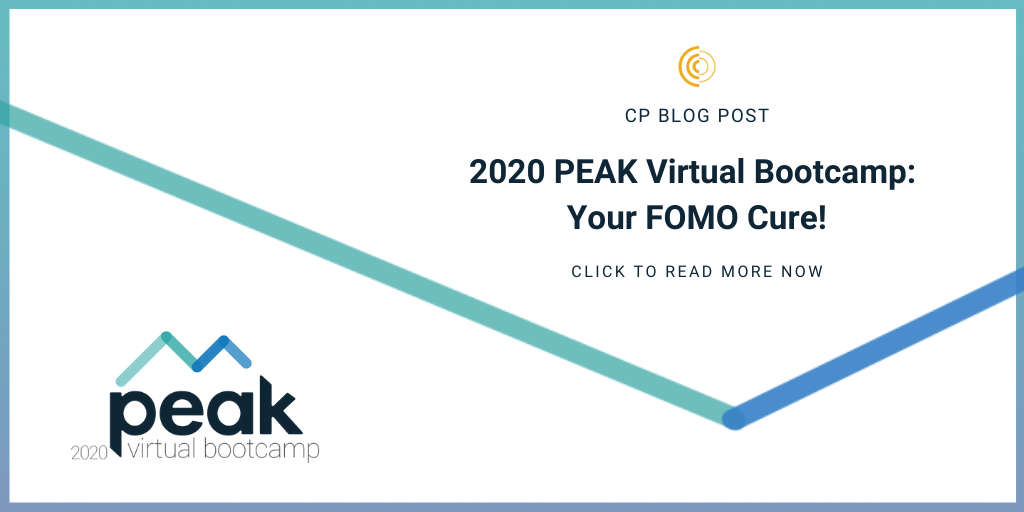
by Julie Ratcliffe | Aug 7, 2020 | Blog
This year, PEAK took the shape of a Virtual Bootcamp, an afternoon of rewarding sessions featuring the expertise of the CommPartners team and covering a topic that is top of mind: Virtual Conferencing.
While we specialize in eLearning and managed online events, we do enjoy meeting our community face-to-face at our User Group Conference, so we were disappointed we couldn’t be at Nationals Stadium this year to do just that. However, we were excited to adapt to a virtual event so we could demonstrate what’s possible.
If you’re experiencing some FOMO (fear of missing out) right now, fear not – we have a cure! Here is a run-down of some key takeaways from each session!
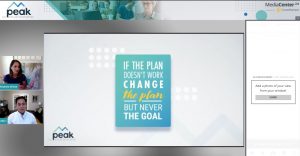 Session 1: Adapting with CommPartners + Virtual Conferencing Basics
Session 1: Adapting with CommPartners + Virtual Conferencing Basics
-
-
- Secure “Buy-In”: Before going virtual, show members of your organization what others in your industry are doing. “The trend is your friend,” as Maricela Arias-Cantu, Director of Professional Development, SOPHE said in the Client Panel.
- Avengers Assemble! Create an event team with clearly defined roles.
Session 2: Session 2: Sponsorship, Exhibit Halls, Discussion Boards, Oh My!
-
-
- What’s on the Menu? Create an exhibitor prospectus to ensure sponsor visibility.
- Get Creative! Connect with speakers, sponsors, and attendees through discussion boards, photo or social media walls, Virtual Happy Hours, games, musical or comedy acts, entertainers, or celebrity appearances – the possibilities are endless!
Session 3: How to Make Your Virtual Conference Website “Pop!”
-
-
- It’s All About UX: The goal of the conference website is to encourage engagement before, during, and after the event.
- Redundancy in Navigation: Make sure your attendees know where to find essential information like sessions, FAQs, exhibit halls, resources, etc.
Session 4: Client Success Panel and Q&A

-
-
- Be Flexible When Pivoting to a Virtual Event: GFOA narrowed their sessions down from 80 to 47 and spread them out over four weeks.
- Find Harmony: Establish a balanced relationship between your event team and the Conference Producer.
- Know Your Industry! AAWA was the first organization to go virtual in their industry and offered a discount to anyone who previously registered for a canceled conference.
- Explore the Benefits of Pairing Your Virtual Conference with an LMS: Bundle your on-demand content or make launching your conference site a breeze with an LMS!
Thank you to everyone who attended PEAK 2020 Virtual Bootcamp, we hope you feel empowered and prepared to take on your next virtual event with confidence.
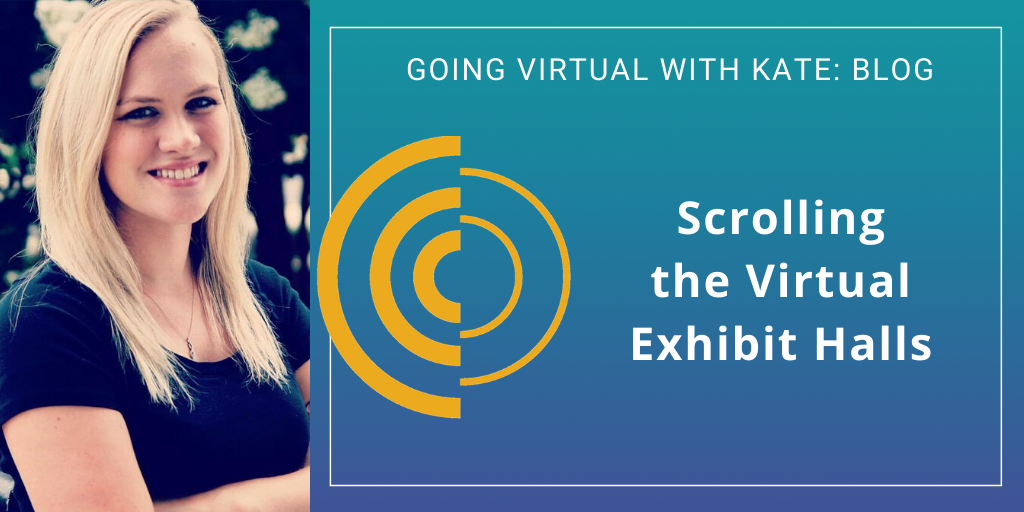
by Julie Ratcliffe | May 21, 2020 | Blog, FaceBook Live
As you transition your on-site event to a Virtual Conference, it is important to consider how you will include the sponsors and other revenue opportunities your organization was counting on while providing a resource center for attendees. In a previous post, we touched on how to monetize your Virtual Conference, including integrating a Virtual Exhibit Hall into your Virtual Conference. Exhibit Halls can be converted to an online format easily and can be just as informative for attendees.
Designing Your Exhibit Hall
A Virtual Exhibit Hall is a home base for all your sponsors. The exhibit hall and each booth can be personalized, depending on the needs of your organization and sponsors/exhibitors. Before designing your Exhibit Hall, identify what features and customization you will be offering to sponsors/exhibitors in their booths.
PDFs, links, or any other resources that would typically be provided to attendees can be housed here. Video and photo assets like commercials or instructional videos or even photo albums can have a dedicated section apart from the downloadable assets and links, all within the individual booths. Going virtual doesn’t mean you lose all the exhibit’s visual and branding opportunities; sponsor logos can be presented in a carousel or posted in various positions around the conference site. Informational and educational posters can be displayed in each sponsor booth, or you can show them all in a collection on a separate posters page
Additional booth features include options for exhibitors and attendees to interact. In each exhibitor booth, there can be a dedicated section for exhibitor staff to “man” the booths and network with attendees via a chat feature. A successful virtual booth should be customized to match the sponsor/exhibitor branding. Have them submit logos or supporting images for greater brand presence.
When it comes to transitioning an Exhibit Hall from in-person to virtual, it just requires some creativity. Use this guide to see how easy it is to transform your on-site Exhibit Hall to a Virtual Exhibit Hall.
Make it Interactive
Once you’ve designed the perfect virtual hall to display your sponsors/exhibitors, the next step is to make sure your attendees interact with the page and the exhibitors. Sponsors are an important part of the vitality of your conference and learners should engage with them. Unlike at an on-site event, where exhibitors are confined to Exhibit Hall hours, your Virtual Exhibit Hall will be open 24/7. Use these tips to encourage activity on your Virtual Exhibit Hall:
- Chat Feature: Whether it’s instant messaging or a discussion board, provide ways for attendees to interact with sponsors.
- Scavenger Hunt: Organize a scavenger hunt around the entire Virtual Conference website leading attendees to the Virtual Exhibit Hall. You can make higher-level sponsors a required stop on the scavenger hunt!
- Credits or Certifications: Offer your attendees a certificate or credit opportunities if they network or interact with sponsors or exhibitors.
- Giveaways/Specials: Encourage your sponsors to offer specials or product giveaways when attendees visit their booth.
- Surveys: Include a survey on your expo page.
- Forms: Embed a Contact Me form to grow your subscriber list.
Including a Virtual Exhibit Hall can be a creative solution to include sponsors, provide more educational resources, and deliver a community-building opportunity. Create a stronger learning community with an interactive Exhibit Hall.
Click here to learn more
To learn more about Virtual Exhibit Halls, contact marketing@commpartners.com
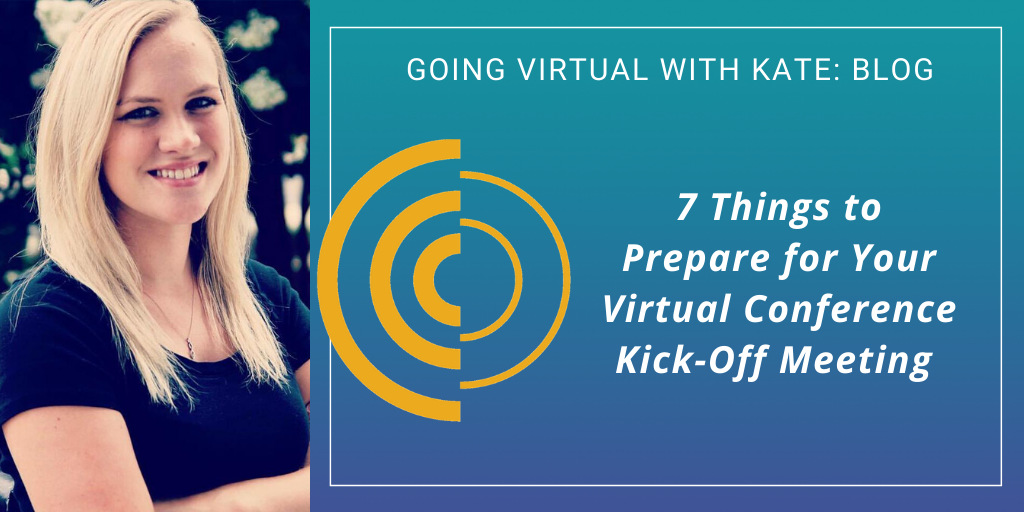
by Julie Ratcliffe | Apr 30, 2020 | Blog, FaceBook Live
One of the first steps in hosting a Virtual Conference with CommPartners is to meet with a Project Manager for a kick-off call. You likely went over some details during the sales call, but now will you dive more in-depth with your producer to take your conference to the next level. To ensure this process is as smooth as possible and production gets started without a hitch, here are a few things you can prepare for this meeting.
What are the dates of your conference?
You have probably established this information by the time you have spoken with the sales team and signed a contract, but if you have reached this point and have not set dates, expect that it will slow things down.
What do you want your conference website to look like?
Elevate clients can create a completely customized conference website. Having an idea of what you’d like your site to look like will speed the creation process up. Here are some things to consider:
- Will you use a sub-domain name of your website or will you use CommPartners’ domain name?
- Will you create an entirely new design theme or base it off your main site?
- What Elevate features and widgets will you include?
- What will your page navigation look like?
You should also be prepared to share files of your color palettes, logos, and any other images associated with your organization that you’ll want to include on your site. CommPartners is happy to help with any questions regarding your conference site environment, but for a truly custom look, arrive at the meeting with a prepared vision or idea.
How do you plan to handle registration?
Decide if your organization is going to process registration internally or if registration is going through the Elevate website. Both are possible, but your producer will need to know at the onset if registration is going through Elevate. The registration process will need to be built-in to the site and time may need to be added to the production timeline.
What does your agenda look like?
At this point, you should have a timeline prepared for your conference. Details about speakers and the sessions are not necessary, but your Project Manager needs to know when each session is happening, including breaks. They need to know you have left enough time for your learners to go from session to session plus take any necessary breaks.
At an in-person conference, learners have a certain amount of time to arrive at their next session. They have time to mingle in the hall or read the literature posted around the conference. There are also plenty of breaks built into the schedule for meals, to get water, go to the bathroom, and check email. Include breaks in your virtual conference agenda, as your virtual learners are doing the same things. They need to take personal breaks, look for the next session on the conference website, or address any technical difficulties they may have. They may also experience fatigue from online learning. Most are not accustomed to learning in this way and need breaks from the screen. Be sure that you include enough breaks in your schedule to accommodate the needs of your learners.
What is your session format?
Once you have you have a clear picture of what your agenda will look like, it is helpful to know what format your sessions will take. You have many options to choose from, will your speakers use just webcams? Slides and audio? A combination? Will some sessions be pre-produced? This can be a more in-depth discussion with your Project Manager at the meeting, but be prepared to tell them your expected attendance for the conference. It will help them choose the right format for your sessions.
Will you include sponsors?
Virtual Conferences offer several monetization options, and sponsorship is one of them. Be ready to let your Project Manager know what’s been sold to sponsors and at what level. Will there be sponsor videos or will your sponsors be introducing sessions? Are you including a Virtual Exhibit Hall?
A Virtual Exhibit Hall is home on your conference site for all the resources a sponsor can distribute to attendees. In each “exhibit booth,” the sponsor can upload PDFs, videos, company descriptions and links, and other assets. The exhibit hall will be open 24/7 – giving sponsors the opportunity for constant exposure.
Be creative when thinking of ways to include sponsors and be sure to prepare a list of participating sponsors for your Project Manager.
Will you include post-conference/session actions?
Finally, decide upfront if attendees are receiving items like credit, certificates, or evaluations after they have completed something at your conference. You then need to determine if they will receive them after each session or after the whole conference has concluded. If there is anything else attendees should receive after a session or the conference, now is the time to alert your Project Manager. These are actions that must be built-in into the site during the early stages.
By considering all of these questions before your first meeting with your Virtual Conference Project Manager, you not only save them time, you also save you and your team time. It will eliminate the amount of back-and-forth that usually occurs when trying to coordinate an event like this and advances the production timeline.
If you have any questions about your first kick-off meeting or would like to speak a sales representative, click here:
Contact Meghan Gowan, VP of Client Development at
mgowen@commpartners.com.
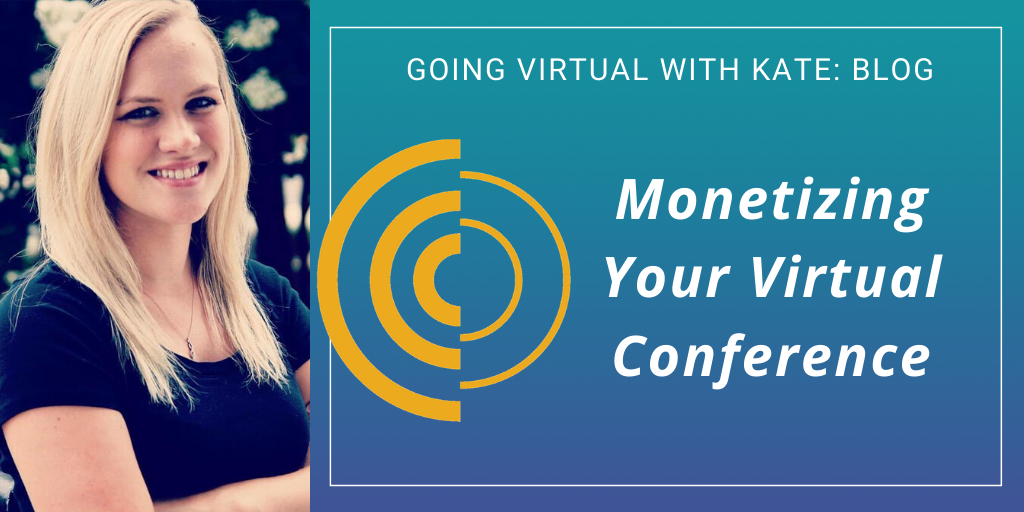
by Kate Ratcliffe | Apr 9, 2020 | Blog, FaceBook Live, Uncategorized
Going virtual doesn’t mean that you lose everything that an on-site event has! A lot of what you had planned for your on-site event can still occur online, it just may look a little differently.
Here are six ways you can maximize sponsorships and attendee revenue in a virtual platform:
Exhibit Halls
In your conference website, a virtual exhibit hall can be built out to house all the resources a sponsor wants to distribute to attendees. In each “exhibit booth”, the sponsor can upload PDFs, videos, company descriptions and links, and other resources. The exhibit hall will be open 24/7 – giving even more exposure for the sponsors that originally intended. The “exhibit booths” can also be upgraded to allow chat room style discussions between attendees and staff from the sponsoring organization. Your sponsors will get maximum and continual exposure to your attendees and will serve as a resource for attendees throughout the conference with having to have a booth “maned” the entire time.
Branding and Logo Opportunities
Because you are building this virtual conference site from the ground up – you have the ability to make an al a carte sponsorship of nearly any page on the website. Have a poster session? Offer this page a sponsorship add-on, with their logo in a prominent location on this busy web page. Giving an option for boosted exposure on commonly used pages on the virtual conference exposure is another way the sponsors can ensure they are getting ROI.
Commercials or Pre-Produced Videos
Sponsors could upgrade their commitment level to include a commercial or pre-recorded video to play before or after a session in the virtual conference. All the sponsor needs to do is provide the video ahead of time and it can be queued up! This gives the sponsor the attendees undivided attention, as they are preparing for or concluding a session. You can also chose to have that video as a permanent part of the archived recording, which means evergreen exposure for the sponsor!
Session and Speaking Opportunities
There are numerous ways to offer speaking opportunities to your sponsors in exchange for financial support. You can offer an entire session to sponsors, or you can create a while section of your agenda dedicated to sponsors giving presentations! Allowing the sponsors to present gives them the feeling that they may miss of being in front of human people. It give a human interaction to a virtual setting.
Attendee Access Fees
Just as you would charge a registration fee for an on-site conference, you should be charging a registration fee for access to the virtual event. You can also break the access into per day or per session registrations if that suits your conference model better. You can also charge for access to various, high-profile discussions or resources. Attendee fees should not necessarily be less for a virtual conference, because while you are eliminating food and venue costs, you are now gaining hosting and technology costs.
Subscription Fees
Allowing your content to live on in an LMS is a smart move. You are able to continually add to your archive through the years of events and house more resources for 24/7 access. Just because an attendee paid for the conference does not necessarily mean they should receive access to the archives for an undetermined amount of time. You could restrict access to archives and other resources to those that choose to purchase subscriptions to your LMS platform. Entice your attendees to subscribe by offering exclusive content in the subscription model only.
Whether you are going virtual from the onset or rescheduling an onsite event, the conversation about monetization is important and necessary. There are many ways to drive revenue for a Virtual Conference, and these six options are only scratching the surface! Have any other ideas on how to boost revenue in a virtual format? We would love to hear from you at marketing@commpartners.com
Click HERE to see all the episodes from Going Virtual with Kate!

 Session 1: Adapting with CommPartners + Virtual Conferencing Basics
Session 1: Adapting with CommPartners + Virtual Conferencing Basics




